fuel YAMAHA YZ65 2021 Owners Manual
[x] Cancel search | Manufacturer: YAMAHA, Model Year: 2021, Model line: YZ65, Model: YAMAHA YZ65 2021Pages: 92, PDF Size: 5.04 MB
Page 8 of 92

Table of contents
Location of important la bels ........... 1-1
Safety information ............................ 2-1
Description ....................................... 3-1
Left view ......................................... 3-1
Right view ....................................... 3-2
Controls and instruments ............... 3-3
Instrument an d control functions ... 4-1
Handlebar switch............................ 4-1
Clutch lever .................................... 4-1
Shift pedal ...................................... 4-2
Brake lever...................................... 4-2
Brake pedal .................................... 4-3
Fuel tank cap .................................. 4-3
Fuel ................................................. 4-4
Fuel tank breather hose.................. 4-6
Fuel cock ........................................ 4-7
Starter (choke) knob ....................... 4-7
Kickstarter ...................................... 4-8
Seat ................................................ 4-8
Adjusting the front fork ................... 4-9
Front fork bleeding ....................... 4-11
Adjusting the shock absorber assembly ................................... 4-12
Removable sidestand ................... 4-16
YPVS system ................................ 4-17
For your safety – pre-operation
checks ............................................... 5-1
Operation an d important ri din g
points ................................................ 6-1
Engine break-in .............................. 6-1
Starting and warming up a cold
engine ......................................... 6-3
Starting a warm engine .................. 6-3
Shifting ........................................... 6-4
Parking ........................................... 6-5
Perio dic maintenance an d
a d justment ........................................ 7-1
Periodic maintenance and lubrication chart .......................... 7-2
Checking the spark plug ................ 7-6 Transmission oil .............................. 7-7
Coolant ............................................ 7-8
Cleaning the air filter element ....... 7-10
Adjusting the carburetor ............... 7-12
Adjusting the engine idling
speed ......................................... 7-12
Adjusting the throttle grip free play ............................................ 7-13
Tires .............................................. 7-14
Spoke wheels ................................ 7-16
Adjusting the clutch lever free play ............................................ 7-16
Checking the brake lever free play ............................................ 7-17
Checking the shift pedal ............... 7-18
Checking the front and rear brake pads ................................. 7-18
Checking the brake fluid level ....... 7-19
Changing the brake fluid ............... 7-20
Drive chain slack ........................... 7-21
Cleaning and lubricating the drive chain ................................. 7-22
Checking and lubricating the
cables ........................................ 7-23
Checking and lubricating the throttle grip and cable ............... 7-23
Checking and lubricating the brake and clutch levers ............. 7-24
Checking and lubricating the
brake pedal ................................ 7-24
Lubricating the rear suspension.... 7-25
Lubricating the swingarm pivots ... 7-25
Checking the front fork ................. 7-26
Checking the steering ................... 7-26
Checking the wheel bearings ........ 7-27
Supporting the motorcycle ........... 7-27
Front wheel ................................... 7-28
Rear wheel .................................... 7-29
Troubleshooting ............................ 7-30
Troubleshooting chart ................... 7-31
Motorcycle care an d stora ge .......... 8-1
Matte color caution ......................... 8-1
Care................................................. 8-1
Storage............................................ 8-4
UBR882E0.book Page 1 Wednesd ay, February 26, 2020 11:39 AM
Page 22 of 92

Safety information
2-4
2Aftermarket Parts, Accessories, an
d
Mo difications
While you may find aftermarket prod-
ucts similar in design and quality to
genuine Yamaha accessories, recog-
nize that some aftermarket accesso-
ries or modifications are not suitable
because of potential safety hazards to
you or others. Installing aftermarket
products or having other modifications
performed to your vehicle that change
any of the vehicle’s design or operation
characteristics can put you and others
at greater risk of serious injury or
death. You are responsible for injuries
related to changes in the vehicle.
Keep the following guidelines in mind,
as well as those provided under “Load-
ing” when mounting accessories. Never install accessories that
would impair the performance of
your motorcycle. Carefully inspect
the accessory before using it to
make sure that it does not in any
way reduce ground clearance or
cornering clearance, limit suspen-
sion travel, steering travel or con-
trol operation.
• Accessories fitted to the han- dlebar or the front fork area can
create instability due to improp-
er weight distribution. If acces-
sories are added to the
handlebar or front fork area,
they must be as lightweight as
possible and should be kept to
a minimum.
• Bulky or large accessories may seriously affect the stability of
the motorcycle. Wind may at- tempt to lift the motorcycle, or
the motorcycle may become
unstable in cross winds.
• Certain accessories can dis- place the operator from his or
her normal riding position. This
improper position limits the
freedom of movement of the
operator and may limit control
ability, therefore, such accesso-
ries are not recommended.
Use caution when adding electri-
cal accessories. If electrical ac-
cessories exceed the capacity of
the motorcycle’s electrical sys-
tem, an electric failure could re-
sult, which could cause a
dangerous loss of lights or engine
power.
Aftermarket Tires an d Rims
The tires and rims that came with your
motorcycle were designed to match
the performance capabilities and to
provide the best combination of han-
dling, braking, and comfort. Other
tires, rims, sizes, and combinations
may not be appropriate. Refer to page
7-14 for tire specifications and more in-
formation on replacing your tires.
Transportin g the Motorcycle
Be sure to observe following instruc-
tions before transporting the motorcy-
cle in another vehicle. Remove all loose items from the
motorcycle.
Check that the fuel cock (if
equipped) is in the “OFF” position
and that there are no fuel leaks.
UBR882E0.book Page 4 Wednesd ay, February 26, 2020 11:39 AM
Page 24 of 92
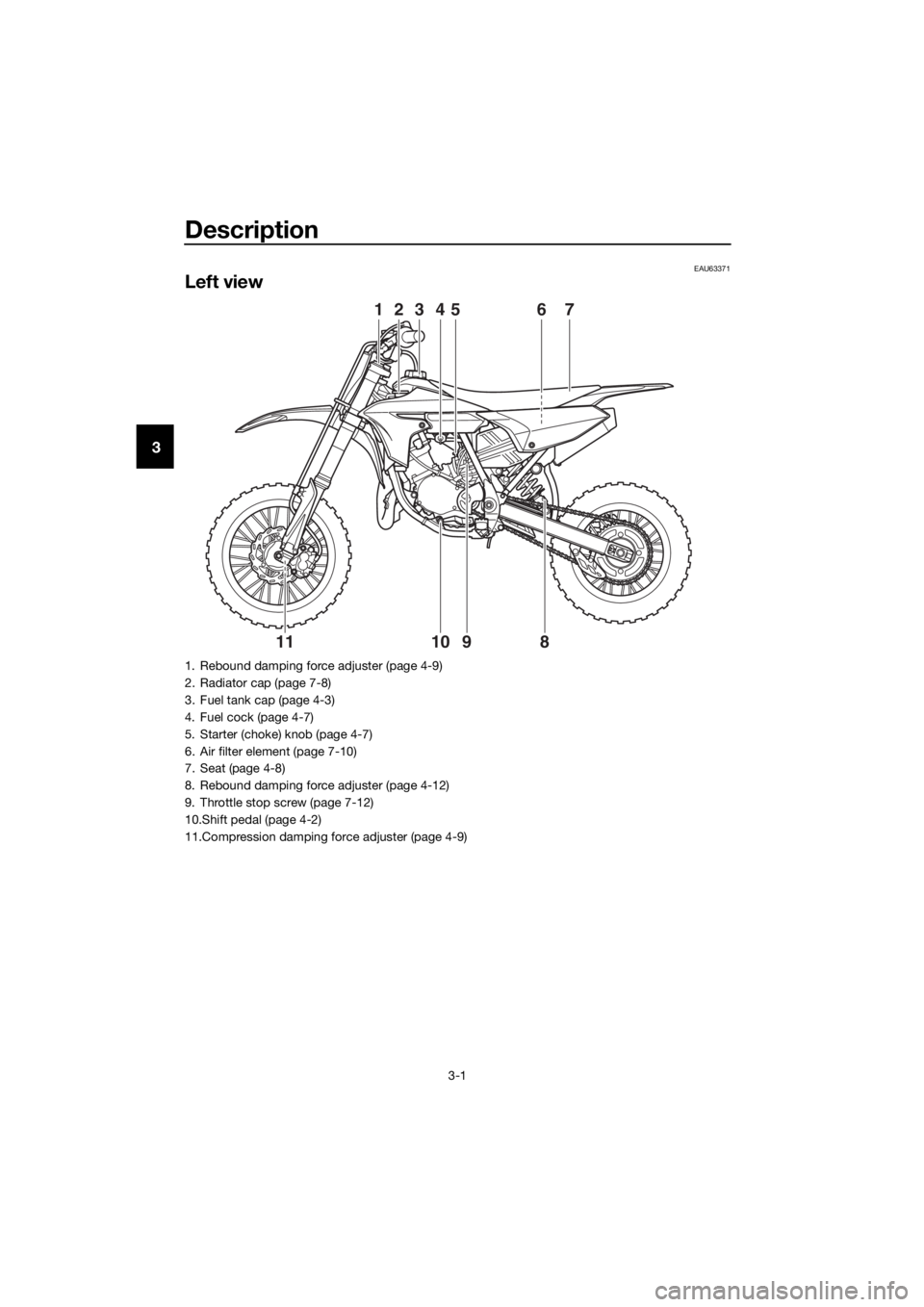
Description
3-1
3
EAU63371
Left view
6745231
981011
1. Rebound damping force adjuster (page 4-9)
2. Radiator cap (page 7-8)
3. Fuel tank cap (page 4-3)
4. Fuel cock (page 4-7)
5. Starter (choke) knob (page 4-7)
6. Air filter element (page 7-10)
7. Seat (page 4-8)
8. Rebound damping force adjuster (page 4-12)
9. Throttle stop screw (page 7-12)
10.Shift pedal (page 4-2)
11.Compression damping force adjuster (page 4-9)
UBR882E0.book Page 1 Wednesday, February 26, 2020 11:39 AM
Page 29 of 92
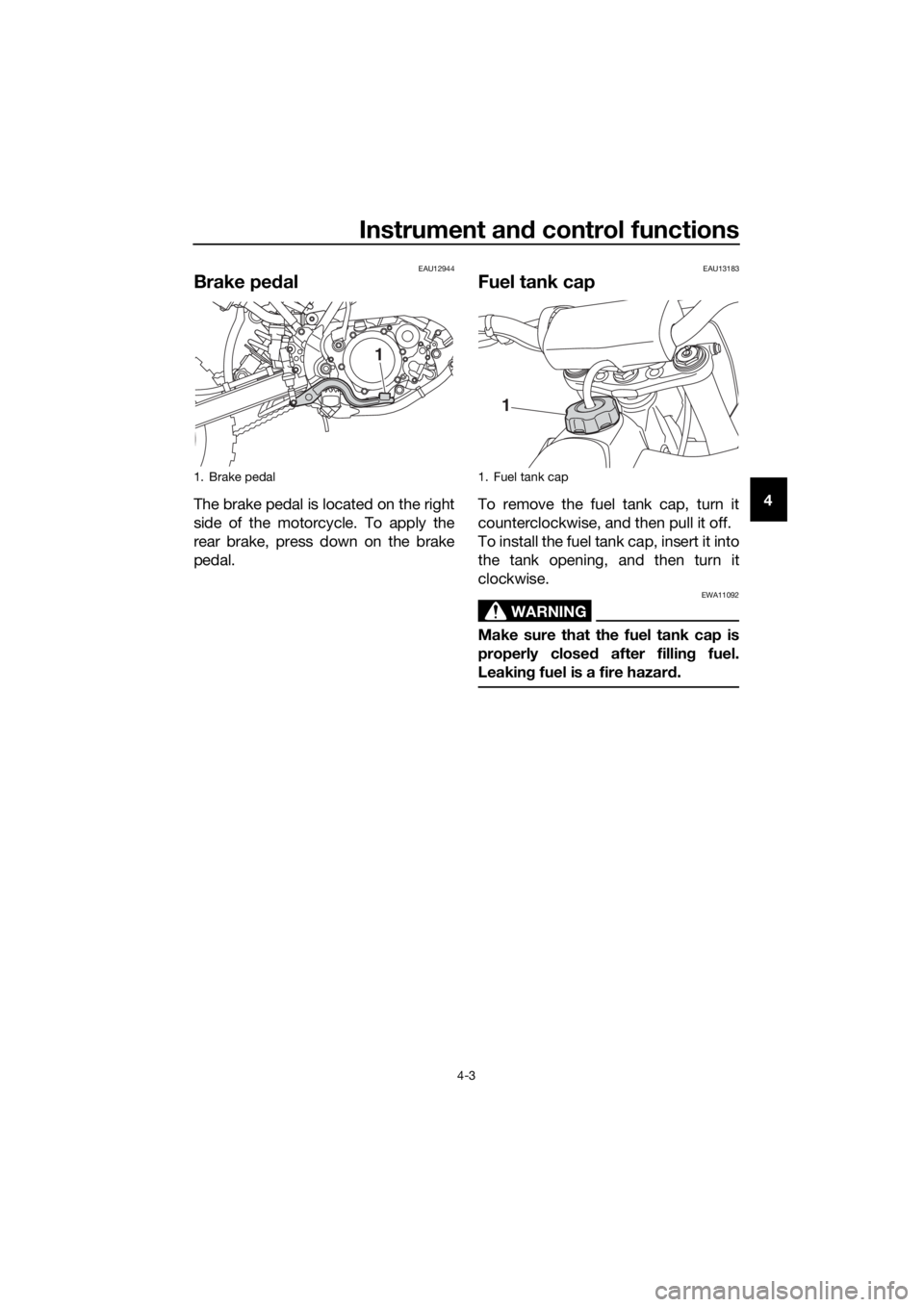
Instrument and control functions
4-3
4
EAU12944
Brake ped al
The brake pedal is located on the right
side of the motorcycle. To apply the
rear brake, press down on the brake
pedal.
EAU13183
Fuel tank cap
To remove the fuel tank cap, turn it
counterclockwise, and then pull it off.
To install the fuel tank cap, insert it into
the tank opening, and then turn it
clockwise.
WARNING
EWA11092
Make sure that the fuel tank cap is
properly close d after fillin g fuel.
Leakin g fuel is a fire hazar d.
1. Brake pedal
1
1. Fuel tank cap
1
UBR882E0.book Page 3 Wednesd ay, February 26, 2020 11:39 AM
Page 30 of 92
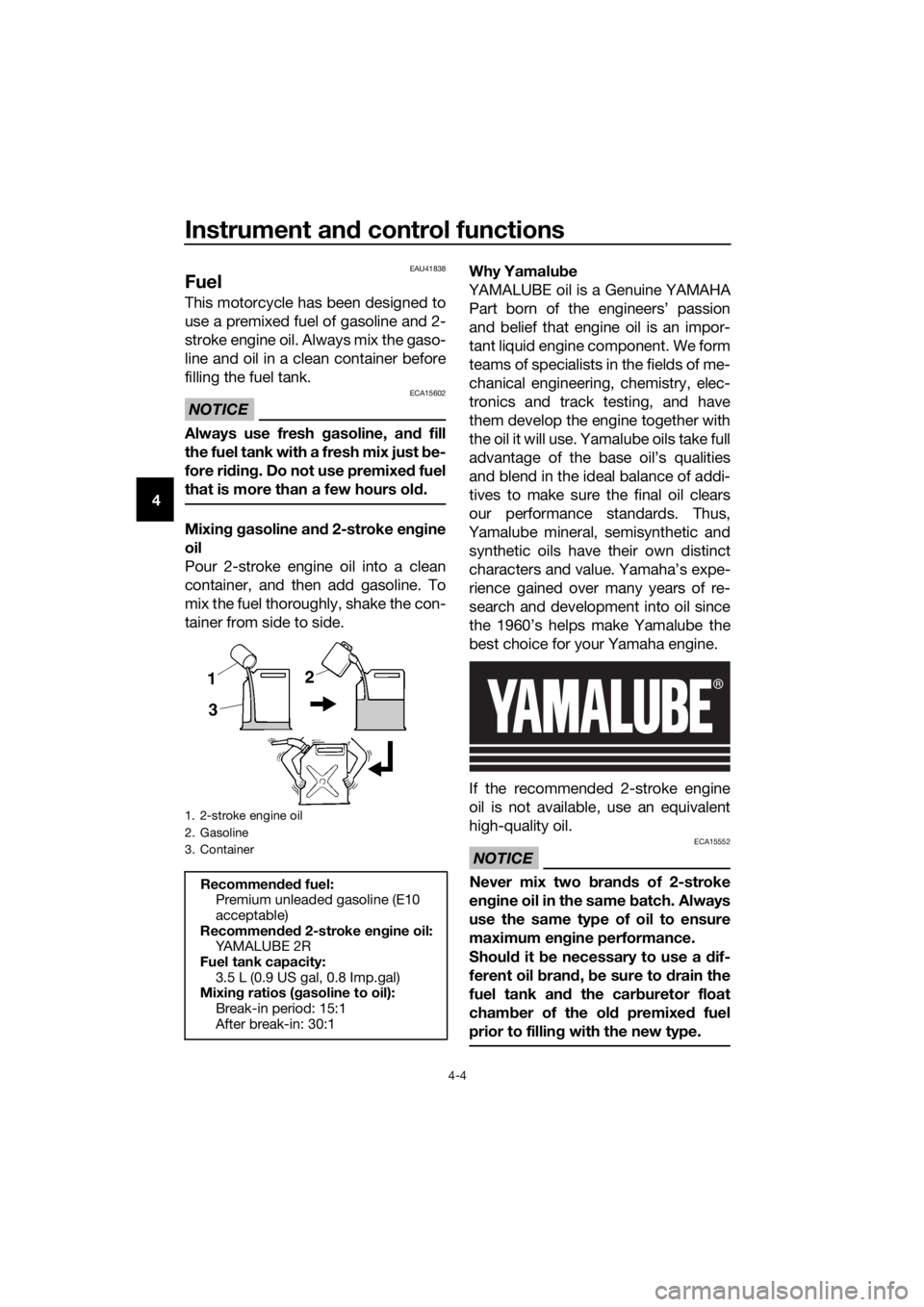
Instrument and control functions
4-4
4
EAU41838
Fuel
This motorcycle has been designed to
use a premixed fuel of gasoline and 2-
stroke engine oil. Always mix the gaso-
line and oil in a clean container before
filling the fuel tank.
NOTICE
ECA15602
Always use fresh gasoline, an d fill
the fuel tank with a fresh mix just be-
fore ri din g. Do not use premixe d fuel
that is more than a few hours ol d.
Mixin g g asoline an d 2-stroke en gine
oil
Pour 2-stroke engine oil into a clean
container, and then add gasoline. To
mix the fuel thoroughly, shake the con-
tainer from side to side. Why Yamalu
be
YAMALUBE oil is a Genuine YAMAHA Part born of the engineers’ passion
and belief that engine oil is an impor-
tant liquid engine component. We form
teams of specialists in the fields of me-
chanical engineering, chemistry, elec-
tronics and track testing, and have
them develop the engine together with
the oil it will use. Yamalube oils take full
advantage of the base oil’s qualities
and blend in the ideal balance of addi-
tives to make sure the final oil clears
our performance standards. Thus,
Yamalube mineral, semisynthetic and synthetic oils have their own distinct
characters and value. Yamaha’s expe-
rience gained over many years of re-
search and development into oil since
the 1960’s helps make Yamalube the
best choice for your Yamaha engine.
If the recommended 2-stroke engine
oil is not available, use an equivalent
high-quality oil.
NOTICE
ECA15552
Never mix two bran ds of 2-stroke
en gine oil in the same batch. Always
use the same type of oil to ensure
maximum en gine performance.
Shoul d it be necessary to use a dif-
ferent oil bran d, b e sure to drain the
fuel tank an d the car buretor float
cham ber of the ol d premixe d fuel
prior to fillin g with the new type.
1. 2-stroke engine oil
2. Gasoline
3. Container
Recommen ded fuel:
Premium unleaded gasoline (E10
acceptable)
Recommen ded 2-stroke en gine oil:
YA M A L U B E 2 R
Fuel tank capacity: 3.5 L (0.9 US gal, 0.8 Imp.gal)
Mixin g ratios ( gasoline to oil):
Break-in period: 15:1
After break-in: 30:1
UBR882E0.book Page 4 Wednesd ay, February 26, 2020 11:39 AM
Page 31 of 92
![YAMAHA YZ65 2021 Owners Manual Instrument and control functions
4-5
4
Gasoline
This model’s engine is designed to use
premium unleaded gasoline with a
pump octane number [(R+M)/2] of 91
or higher, or a research octane number
(RON YAMAHA YZ65 2021 Owners Manual Instrument and control functions
4-5
4
Gasoline
This model’s engine is designed to use
premium unleaded gasoline with a
pump octane number [(R+M)/2] of 91
or higher, or a research octane number
(RON](/img/51/54008/w960_54008-30.png)
Instrument and control functions
4-5
4
Gasoline
This model’s engine is designed to use
premium unleaded gasoline with a
pump octane number [(R+M)/2] of 91
or higher, or a research octane number
(RON) of 95 or higher. If knocking or
pinging occurs, try a gasoline of a dif-
ferent brand.
NOTICE
ECA15591
Use only unlea
ded g asoline. The use
of lead ed g asoline will cause severe
d ama ge to internal en gine parts,
such as the piston rin gs as well as to
the exhaust system.
Gasohol
There are two types of gasohol: gaso-
hol containing ethanol and that con-
taining methanol. Gasohol containing
ethanol can be used if the ethanol con-
tent does not exceed 10% (E10). Gas-
ohol containing methanol should not
be used as it can cause engine or fuel
system problems.
Fillin g the fuel tank
WARNING
EWA10882
Gasoline an d gasoline vapors are
extremely flamma ble. To avoi d fires
an d explosions an d to re duce the
risk of injury when refueling , follow
these instructions.
1. Before refueling, turn off the en- gine and be sure that no one is sit-
ting on the vehicle. Never refuel
while smoking, or while in the vi-
cinity of sparks, open flames, or
other sources of ignition such as
the pilot lights of water heaters
and clothes dryers.
2. Do not overfill the fuel tank. Stop filling when the fuel reaches the
bottom of the filler tube. Because
fuel expands when it heats up,
heat from the engine or the sun
can cause fuel to spill out of the
fuel tank.
3. Wipe up any spilled fuel immedi- ately. NOTICE: Immediately
wipe off spille d fuel with a clean,
d ry, soft cloth, since fuel may
d eteriorate painte d surfaces or
plastic parts.
[ECA10072]
4. Be sure to securely close the fuel tank cap.
WARNING
EWA15152
Gasoline is poisonous an d can
cause injury or death. Han dle gaso-
line with care. Never siphon gasoline
b y mouth. If you shoul d swallow
some gasoline or inhale a lot of gas-
oline vapor, or get some gasoline in
your eyes, see your d octor immedi-
ately. If g asoline spills on your skin,
1. Maximum fuel level
2. Fuel tank filler tube
12
UBR882E0.book Page 5 Wednesd ay, February 26, 2020 11:39 AM
Page 32 of 92
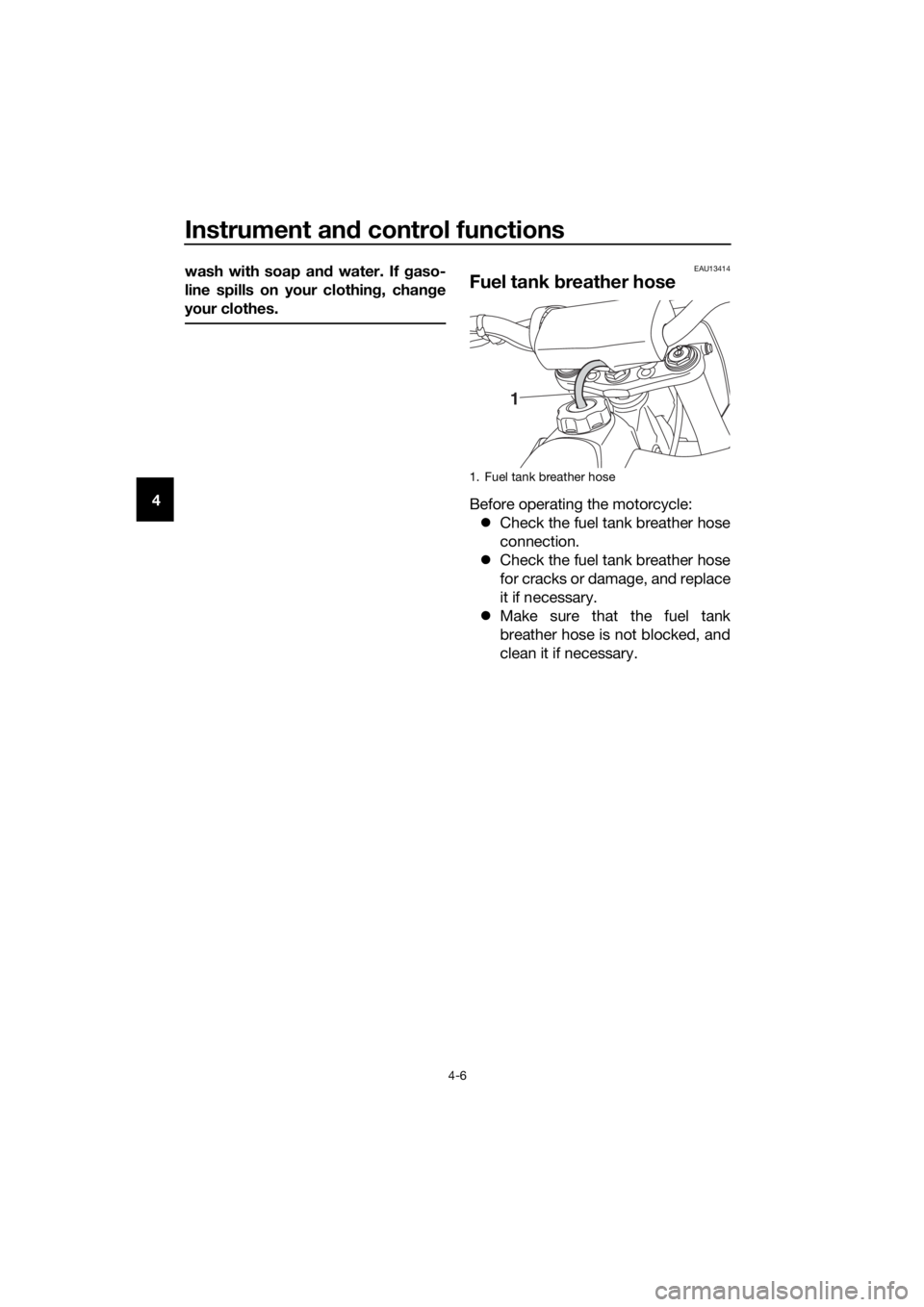
Instrument and control functions
4-6
4 wash with soap an
d water. If gaso-
line spills on your clothin g, chan ge
your clothes.
EAU13414
Fuel tank breather hose
Before operating the motorcycle:
Check the fuel tank breather hose
connection.
Check the fuel tank breather hose
for cracks or damage, and replace
it if necessary.
Make sure that the fuel tank
breather hose is not blocked, and
clean it if necessary.
1. Fuel tank breather hose
1
UBR882E0.book Page 6 Wednesd ay, February 26, 2020 11:39 AM
Page 33 of 92
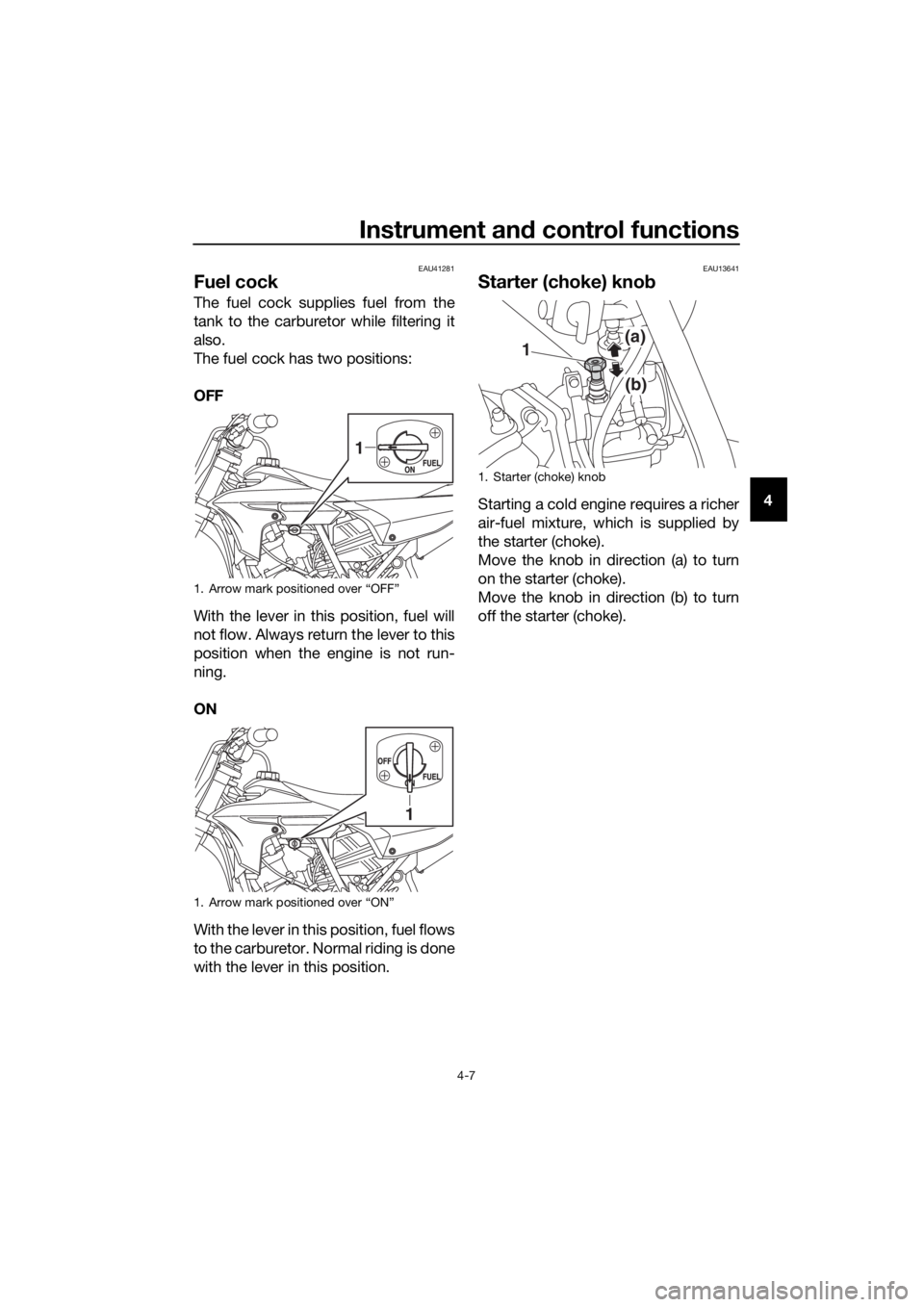
Instrument and control functions
4-7
4
EAU41281
Fuel cock
The fuel cock supplies fuel from the
tank to the carburetor while filtering it
also.
The fuel cock has two positions:
OFF
With the lever in this position, fuel will
not flow. Always return the lever to this
position when the engine is not run-
ning.
ON
With the lever in this position, fuel flows
to the carburetor. Normal riding is done
with the lever in this position.
EAU13641
Starter (choke) kno b
Starting a cold engine requires a richer
air-fuel mixture, which is supplied by
the starter (choke).
Move the knob in direction (a) to turn
on the starter (choke).
Move the knob in direction (b) to turn
off the starter (choke).
1. Arrow mark positioned over “OFF”
1. Arrow mark positioned over “ON”
1
1
1. Starter (choke) knob
1(a)
(b)
UBR882E0.book Page 7 Wednesd ay, February 26, 2020 11:39 AM
Page 34 of 92
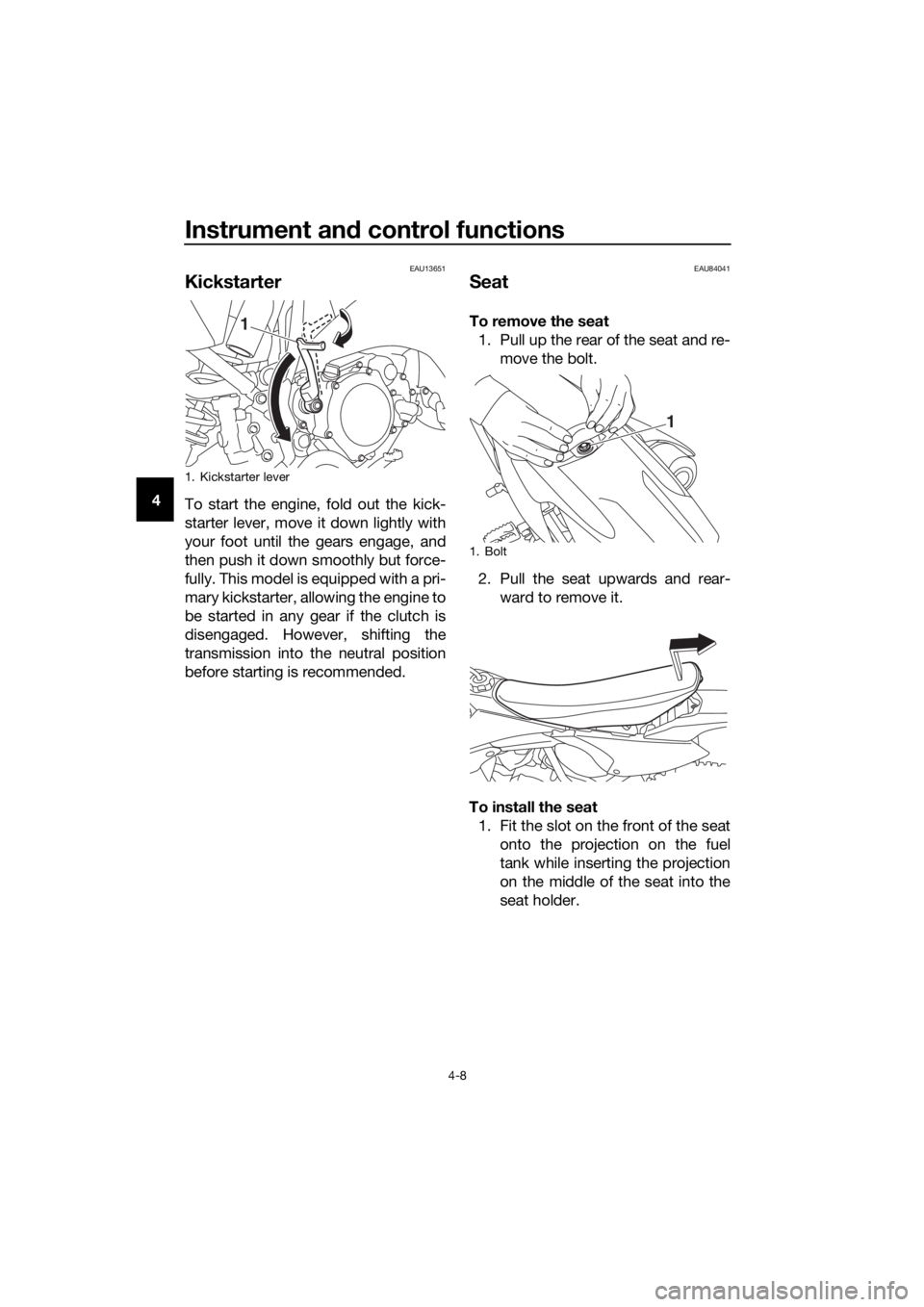
Instrument and control functions
4-8
4
EAU13651
Kickstarter
To start the engine, fold out the kick-
starter lever, move it down lightly with
your foot until the gears engage, and
then push it down smoothly but force-
fully. This model is equipped with a pri-
mary kickstarter, allowing the engine to
be started in any gear if the clutch is
disengaged. However, shifting the
transmission into the neutral position
before starting is recommended.
EAU84041
Seat
To remove the seat
1. Pull up the rear of the seat and re- move the bolt.
2. Pull the seat upwards and rear- ward to remove it.
To install the seat 1. Fit the slot on the front of the seat onto the projection on the fuel
tank while inserting the projection
on the middle of the seat into the
seat holder.
1. Kickstarter lever
1
1. Bolt
1
UBR882E0.book Page 8 Wednesd ay, February 26, 2020 11:39 AM
Page 44 of 92
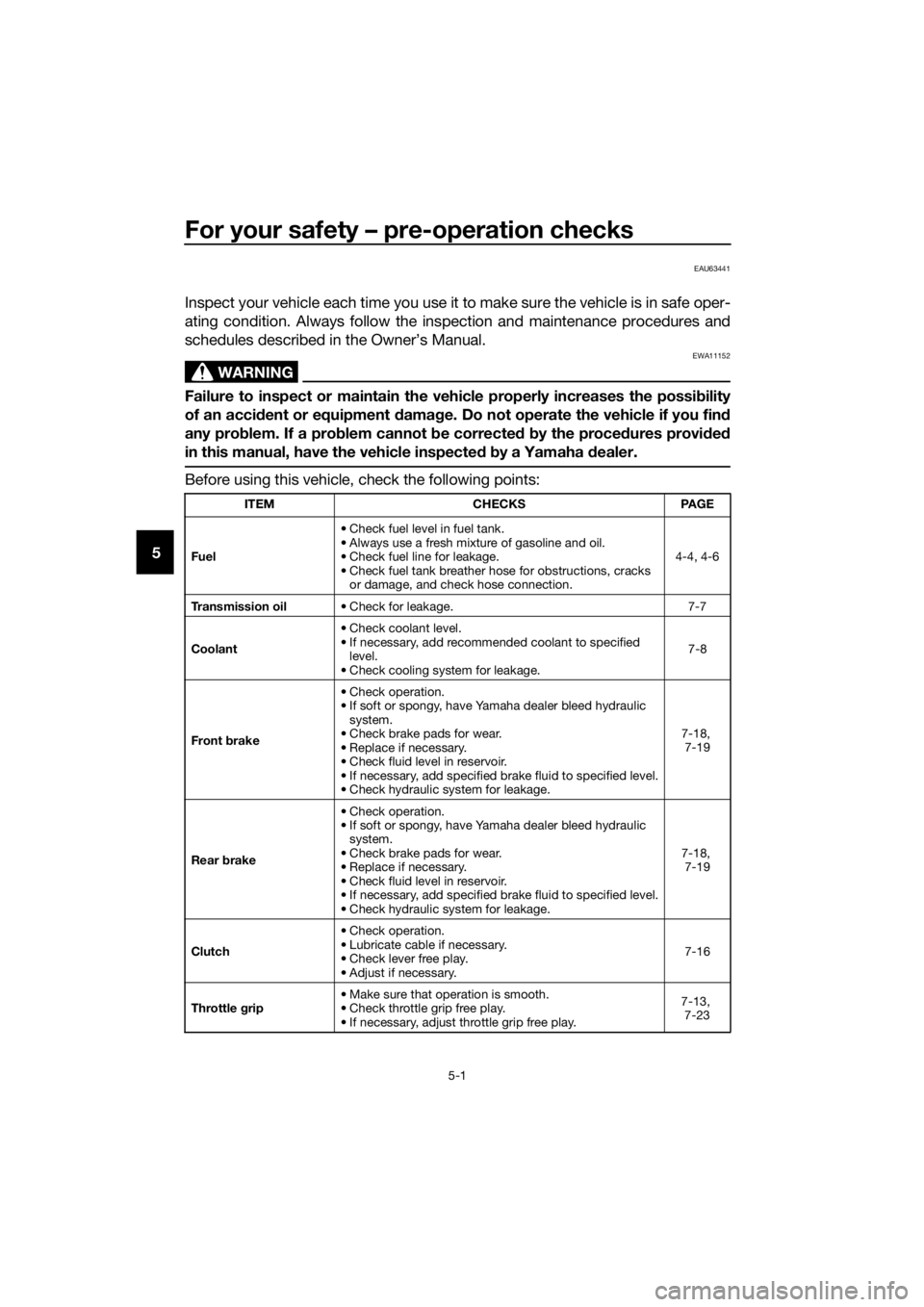
For your safety – pre-operation checks
5-1
5
EAU63441
Inspect your vehicle each time you use it to make sure the vehicle is in safe oper-
ating condition. Always follow the inspection and maintenance procedures and
schedules described in the Owner’s Manual.
WARNING
EWA11152
Failure to inspect or maintain the vehicle properly increases the possibility
of an acci dent or equipment d amage. Do not operate the vehicle if you fin d
any pro blem. If a pro blem cannot be correcte d b y the proce dures provi ded
in this manual, have the vehicle inspecte d b y a Yamaha dealer.
Before using this vehicle, check the following points:
ITEM CHECKSPAGE
Fuel • Check fuel level in fuel tank.
• Always use a fresh mixture of gasoline and oil.
• Check fuel line for leakage.
• Check fuel tank breather hose for obstructions, cracks
or damage, and check hose connection. 4-4, 4-6
Transmission oil • Check for leakage. 7-7
Coolant • Check coolant level.
• If necessary, add recommended coolant to specified
level.
• Check cooling system for leakage. 7-8
Front brake • Check operation.
• If soft or spongy, have Yamaha dealer bleed hydraulic
system.
• Check brake pads for wear.
• Replace if necessary.
• Check fluid level in reservoir.
• If necessary, add specified brake fluid to specified level.
• Check hydraulic system for leakage. 7-18,
7-19
Rear brake • Check operation.
• If soft or spongy, have Yamaha dealer bleed hydraulic
system.
• Check brake pads for wear.
• Replace if necessary.
• Check fluid level in reservoir.
• If necessary, add specified brake fluid to specified level.
• Check hydraulic system for leakage. 7-18,
7-19
Clutch • Check operation.
• Lubricate cable if necessary.
• Check lever free play.
• Adjust if necessary. 7-16
Throttle grip • Make sure that operation is smooth.
• Check throttle grip free play.
• If necessary, adjust throttle grip free play. 7-13,
7-23
UBR882E0.book Page 1 Wednesd ay, February 26, 2020 11:39 AM